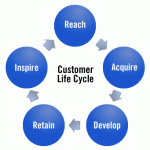Running a PR Agency – Big or Small, Challenges Remain the Same
Last week I was fortunate enough to be invited to the Council of PR Firms‘ Boston roundtable, to discuss industry and agency issues with fellow Boston agency leaders. This was my second time attending this annual event, and I again came away inspired, energized, reassured and enthusiastic. The folks I was lucky enough to sit around the “asylum white” Board room with at Weber Shandwick included agency leaders in executive management, HR and business development from large, global firms such as Porter Novelli, Weber and Fleishman-Hillard, to midsize and smaller agencies such as CHEN PR and March Public Relations. In all, there were about 20 of us who talked about what’s looking up in the PR industry, how PR has evolved since the advent of social and digital media, HR and recruitment challenges, the integration of advertising, digital, social, mobile and video into PR campaigns and much more. We spent a great deal of time talking about measurement – what clients want, how we provide it and what tools and strategies we are using to get there.
The thing that I always find most interesting about meeting with my industry colleagues – some of them even competitors – is that we all face similar issues. Large or small, focused on tech or healthcare or consumer PR – the agency challenges are always along the same lines. As the owner of one of the smaller agencies, I love to hear that we are successfully navigating the same issues that agencies of any size do – how to motivate staff, how to identify and hire the right people for our culture, how to juggle client demands with realistic budgets. It reminds me that sometimes getting together with your “frenemies,” as I like to call them, benefits everyone. Here are some of the issues that resonated across the board:
Recruiting. Currently, the biggest challenge is finding social and digital experts who understand communications strategy and PR. It’s easy to find one or the other, but the combination of both is valuable and rare. PR folks –that’s an open invitation to you to hone your social and digital skills and surpass those “social media experts” for jobs that require knowing more than how to Tweet. What’s the real value in using these tools in a strategic communications campaign?
HR. One of the big issues on the table was telecommuting and virtual work. I am obviously – as an owner of one of the first and most successful virtual agencies – fortunate to not have to deal with a traditional office environment where executive staff is trying to figure out how to provide the opportunity for employees to work from home some of the time. That balancing act can get tricky – providing the perk without it getting out of control, managing expectations between management and staff and still keeping employees motivated and happy. Almost every agency provides the opportunity to work from home some of the time for some of their employees, but much was discussed about how this affects training of junior staff, expectations from clients, and the overall culture. Apparently the new wave of workers expects this perk, so agencies are navigating their way and trying some interesting combinations of integrating virtual work with traditional office environments. Other topics on the HR front were how to manage employee demands for more and better perks, investment in training and opportunities for growth from within, as well as the return of bloated salary requests. We were all enthusiastic about joining an HR roundtable next to continue to inform one another and discuss these issues – helping to keep the industry in check.
Client Expectations. This is always a topic of discussion and I was glad to hear that budgets all around are returning to a more realistic level to align with the results desired by clients. Remember, you really do get what you pay for in PR. You can’t expect to saturate the market if you don’t put the proper investment behind that (money, time and executive commitment and belief). Remember what Bill Gates allegedly said about his last dollar…
Measurement and Proof of Value. Speaking of client expectations, the burden of proof of reaching those expectations continues to drive discussions within all agencies. We talked about using tools such as Radian 6 and (our PerkettPR client) uberVU. We discussed the value of measuring how our promotions are driving traffic, sales leads, brand awareness and more – but the challenge remains to find the exact best way to do this. There is no PR industry standard and furthermore, clients don’t want to pay extra for it. The burden of proof is on PR firms – and how the different agencies handle that is all over the place. (On a self promotional note, our agency is working on a tool that fellow firms will definitely find of value – stay tuned for our launch this Fall.)
Competition. A great deal of discussion was spent on how PR agencies are taking business not from each other, but from other entities such as advertising agencies, digital houses and even the new found “social media” agencies. The common belief – and trend we’re all seeing – is that the shiny new ball syndrome of hiring an entire agency to execute social media is quickly fading. Social media is simply a new set of tools, not an enlightenment of communications strategy for newbie professionals who have never dealt with brand strategy, corporate crisis and more. The competitive landscape is wider, but PR is holding its own, as effective communications that illicit the proper actions continues to be key. Also hot for PR agencies is adding staff for mobile, digital and video content. Most agencies are moving from outsourcing this type of position to owning it in-house with a dedicated team or position.
I do believe there were a few laughs when I mentioned that the telephone has been around for quite a while, but it certainly doesn’t make everyone good at communicating. It’s true – and neither do social media tools. This is why the PR industry is not dying. We’re thriving – and our 2012 budgets and client rosters continue to reflect that truth. I can’t wait to see what 2013 brings to us as an industry.
If you’re a PR executive or agency, what trends are you seeing in the above areas? How are you navigating the changes discussed (or the traditional issues we all still face)?
Thanks to Weber for hosting, and to Matthew Soriano and the Council for including me. And of course, to my industry colleagues for participating. It’s always a pleasure learning from you all.
PS Head on over to the Council’s website for more industry stats, insights and information! It’s a great resource.

 This week’s “Effective Executives” interview is with
This week’s “Effective Executives” interview is with  Most forms of marketing and advertising focus on attracting and engaging customers through a sales cycle to create awareness and interest, guiding the customer to consider and purchase. Lee Odden writes on
Most forms of marketing and advertising focus on attracting and engaging customers through a sales cycle to create awareness and interest, guiding the customer to consider and purchase. Lee Odden writes on  If your brand has a social media presence, consumers need to hear from you.
If your brand has a social media presence, consumers need to hear from you. 


 As the business of social media continues to grow, social media tools – and the marketers who use them – are expanding their reach into nearly every social media network they can find. Brian Proffitt at
As the business of social media continues to grow, social media tools – and the marketers who use them – are expanding their reach into nearly every social media network they can find. Brian Proffitt at  With the rapid proliferation of social media and social media channels, there’s been an equally as rapid growth in the creation of memes. While memes tend to be light-hearted, when done well, they can pack a serious marketing punch. Mike Lewis of
With the rapid proliferation of social media and social media channels, there’s been an equally as rapid growth in the creation of memes. While memes tend to be light-hearted, when done well, they can pack a serious marketing punch. Mike Lewis of